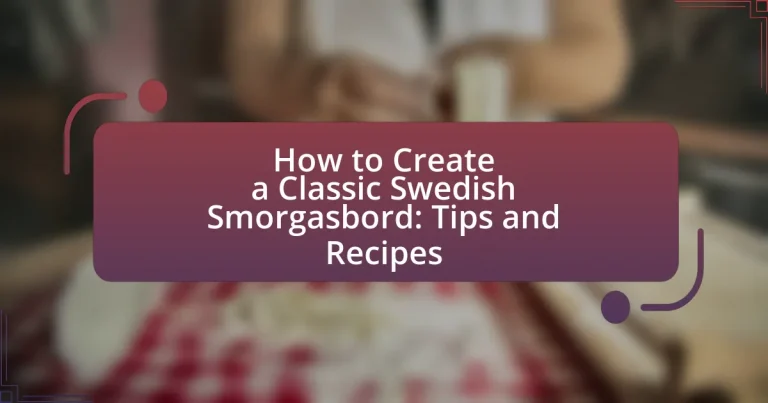A Classic Swedish Smorgasbord is a traditional buffet-style meal that showcases a variety of cold and hot dishes, including herring, cured meats, cheeses, and breads, reflecting Sweden’s culinary heritage and communal dining culture. Originating in the 16th century, this dining experience has evolved over time, incorporating international flavors while maintaining its core elements. Key components of a smorgasbord include carefully prepared dishes such as pickled herring, Swedish meatballs, and gravlax, all presented to enhance visual appeal and encourage social interaction. The article provides essential tips for planning a smorgasbord menu, accommodating dietary restrictions, and includes classic recipes to create an authentic experience.

What is a Classic Swedish Smorgasbord?
A Classic Swedish Smorgasbord is a traditional buffet-style meal featuring a variety of dishes, typically including cold and hot items such as herring, cured meats, cheeses, and bread. This culinary tradition dates back to the 19th century in Sweden, where it was originally served as a way to showcase local ingredients and flavors. The smorgasbord is characterized by its communal nature, allowing guests to sample multiple dishes at their leisure, reflecting the Swedish emphasis on hospitality and social dining.
How did the tradition of Smorgasbord originate in Sweden?
The tradition of Smorgasbord originated in Sweden as a way to serve a variety of dishes, allowing guests to sample multiple flavors in one meal. This practice dates back to the 16th century when it was common for Swedish nobility to host lavish feasts featuring an array of foods. The term “Smorgasbord” itself combines “smörgås,” meaning sandwich or bread, and “bord,” meaning table, reflecting the spread of open-faced sandwiches and other dishes served on a table. Over time, this evolved into a buffet-style meal that became popular in Swedish culture, particularly during festive occasions and gatherings.
What historical influences shaped the Smorgasbord?
The Smorgasbord was shaped by historical influences such as the Viking Age, agricultural practices, and cultural exchanges in Scandinavia. During the Viking Age, communal feasting was common, leading to the tradition of serving multiple dishes. Agricultural advancements in the 19th century allowed for a variety of local ingredients, which contributed to the diverse offerings of the Smorgasbord. Additionally, cultural exchanges with neighboring countries, particularly during trade and migration, introduced new flavors and dishes, further enriching the Smorgasbord experience.
How has the Smorgasbord evolved over time?
The Smorgasbord has evolved from a traditional Swedish buffet featuring a variety of cold and hot dishes into a more diverse and globally influenced dining experience. Initially, it consisted mainly of simple, local ingredients such as herring, cured meats, and bread, reflecting the agricultural practices and seasonal availability of food in Sweden. Over time, particularly in the 20th century, the Smorgasbord began to incorporate international flavors and dishes, influenced by globalization and culinary trends, leading to a broader array of offerings including seafood, salads, and desserts. This evolution highlights the adaptability of the Smorgasbord, allowing it to remain relevant and appealing in contemporary dining culture.
What are the key components of a Classic Swedish Smorgasbord?
A Classic Swedish Smorgasbord consists of a variety of dishes, including herring, cured salmon, meatballs, and various breads. Herring is typically served in multiple preparations, such as pickled or marinated, showcasing traditional flavors. Cured salmon, often gravlax, is seasoned with dill and sugar, providing a distinct taste. Swedish meatballs, made from a mix of ground beef and pork, are a staple, often accompanied by lingonberry sauce. Additionally, a selection of breads, including crispbread and rye, complements the meal. This diverse array of dishes reflects Sweden’s culinary heritage and emphasizes communal dining.
What types of dishes are typically included?
A classic Swedish smorgasbord typically includes a variety of dishes such as herring, meatballs, gravlax, and potato salad. Herring is often prepared in multiple ways, including pickled and marinated, showcasing its versatility. Meatballs, known as köttbullar, are a staple, often served with lingonberry sauce. Gravlax, a cured salmon dish, adds a rich flavor profile, while potato salad provides a hearty side. This combination reflects traditional Swedish cuisine and is commonly found in festive gatherings and celebrations.
How are these dishes traditionally prepared?
Traditional Swedish smorgasbord dishes are prepared using methods that emphasize freshness and simplicity. For example, herring is typically pickled in a brine solution with spices, while meatballs are made from a mixture of ground meat, breadcrumbs, and spices, then pan-fried or baked. Gravlax, a cured salmon dish, is prepared by rubbing salmon fillets with a mixture of salt, sugar, and dill, allowing it to cure for several days. These methods reflect Sweden’s culinary heritage, focusing on preserving ingredients and enhancing natural flavors.
Why is presentation important in a Smorgasbord?
Presentation is important in a Smorgasbord because it enhances the visual appeal and encourages diners to engage with the diverse offerings. A well-presented Smorgasbord showcases the variety of dishes, making it more inviting and stimulating appetite. Studies in food aesthetics indicate that visually appealing meals can increase perceived taste and enjoyment, leading to a more satisfying dining experience.
What are some traditional serving styles?
Traditional serving styles for a Swedish smorgasbord include buffet-style presentation, where dishes are laid out on a long table for guests to serve themselves, and family-style serving, where larger platters are placed on the table for communal sharing. Buffet-style allows for a variety of dishes to be sampled, reflecting the smorgasbord’s emphasis on abundance and variety, while family-style encourages interaction among diners. These styles are rooted in Swedish dining customs, promoting a relaxed and social atmosphere during meals.
How can presentation enhance the dining experience?
Presentation enhances the dining experience by engaging the senses and creating an inviting atmosphere. Visually appealing dishes stimulate appetite and anticipation, making the meal more enjoyable. Research indicates that food presentation can significantly influence perceptions of taste and quality; for instance, a study published in the journal “Appetite” found that well-presented food is often rated as more flavorful and satisfying. Thus, effective presentation not only elevates the aesthetic value of a meal but also enhances the overall dining experience by positively impacting diners’ perceptions and enjoyment.

What are the Essential Tips for Creating a Smorgasbord?
To create a smorgasbord, focus on variety, balance, and presentation. A successful smorgasbord includes a diverse selection of dishes such as herring, cured meats, cheeses, breads, and salads, ensuring that there are options for different tastes and dietary preferences. Balance flavors and textures by incorporating both rich and light items, as well as contrasting temperatures, like warm dishes alongside cold ones. Presentation is key; arrange the food attractively on platters, using garnishes to enhance visual appeal. This approach aligns with traditional Swedish customs, where a well-curated smorgasbord reflects hospitality and culinary artistry.
How do you plan a Smorgasbord menu?
To plan a Smorgasbord menu, start by selecting a variety of dishes that represent traditional Swedish cuisine, ensuring a balance of flavors and textures. A classic Smorgasbord typically includes cold dishes like herring, cured salmon, and various cheeses, alongside hot options such as meatballs and gravlax. Incorporating seasonal ingredients enhances freshness and authenticity, while offering a mix of appetizers, main courses, and desserts caters to diverse tastes. Historical context shows that Smorgasbord originated as a way to showcase a range of dishes, making it essential to include both familiar favorites and unique items to create an inviting spread.
What factors should you consider when selecting dishes?
When selecting dishes for a classic Swedish smorgasbord, consider the balance of flavors, textures, and dietary preferences. A well-rounded smorgasbord includes a variety of cold and hot dishes, such as herring, meatballs, and gravlax, ensuring a mix of savory, sweet, and tangy elements. Additionally, incorporating vegetarian and gluten-free options caters to diverse dietary needs, enhancing the overall appeal of the meal. The traditional aspect of the smorgasbord should also be respected, as it typically features seasonal ingredients and regional specialties, which reflect Swedish culinary heritage.
How can you accommodate dietary restrictions?
To accommodate dietary restrictions, identify specific needs such as allergies, intolerances, or dietary preferences among guests. This can be achieved by offering a variety of dishes that cater to different diets, including vegetarian, vegan, gluten-free, and nut-free options. For instance, providing a selection of salads, vegetable dishes, and alternative protein sources ensures inclusivity. Additionally, clearly labeling all food items with their ingredients helps guests make informed choices. Research indicates that 32% of adults in the U.S. follow some form of dietary restriction, highlighting the importance of diverse menu options to meet these needs.
What are the best practices for preparing dishes in advance?
The best practices for preparing dishes in advance include planning menus, utilizing proper storage techniques, and ensuring food safety. Planning menus allows for efficient use of ingredients and time management, while proper storage techniques, such as using airtight containers and labeling, help maintain freshness and prevent spoilage. Additionally, adhering to food safety guidelines, like cooling cooked dishes quickly and refrigerating them promptly, minimizes the risk of foodborne illnesses. These practices are essential for creating a successful and enjoyable smorgasbord experience.
Which dishes can be made ahead of time?
Dishes that can be made ahead of time for a classic Swedish smorgasbord include herring dishes, meatballs, and potato salad. Herring can be marinated in various sauces and stored for several days, enhancing its flavor. Meatballs can be prepared, cooked, and refrigerated or frozen, maintaining their taste and texture when reheated. Potato salad, made with boiled potatoes, mayonnaise, and vegetables, can be assembled a day in advance, allowing the flavors to meld. These dishes not only save time but also contribute to the overall experience of a traditional smorgasbord.
How should you store and reheat dishes for optimal flavor?
To store and reheat dishes for optimal flavor, use airtight containers to preserve moisture and prevent contamination. Proper storage in the refrigerator or freezer maintains freshness; for example, cooked meats should be refrigerated within two hours and consumed within three to four days. When reheating, use low to medium heat to avoid drying out the food, and cover dishes to retain steam, which enhances flavor. For instance, reheating casseroles in the oven at 350°F while covered with foil helps maintain moisture and flavor integrity.
What role does beverage pairing play in a Smorgasbord?
Beverage pairing enhances the overall dining experience of a Smorgasbord by complementing the diverse flavors of the food. The right beverages, such as aquavit or beer, can elevate the taste of traditional dishes like herring and meatballs, creating a harmonious balance. Studies indicate that specific pairings can enhance flavor perception, making the meal more enjoyable. For instance, aquavit, a traditional Scandinavian spirit, is often served with Smorgasbord to accentuate the flavors of pickled fish and cured meats, demonstrating the importance of thoughtful beverage selection in this culinary tradition.
What traditional beverages complement a Smorgasbord?
Traditional beverages that complement a Smorgasbord include aquavit, beer, and cider. Aquavit, a Scandinavian spirit flavored with herbs and spices, is often served chilled and pairs well with the diverse flavors of the Smorgasbord. Beer, particularly light lagers or traditional Swedish ales, enhances the meal’s savory elements. Cider, especially dry varieties, provides a refreshing contrast to richer dishes. These beverages are commonly enjoyed in Sweden during festive occasions, reinforcing their cultural significance in enhancing the dining experience.
How can you create a balanced drink menu?
To create a balanced drink menu, include a variety of beverages that cater to different tastes and dietary preferences. This should encompass alcoholic options like wines, beers, and cocktails, alongside non-alcoholic choices such as juices, sodas, and water. A balanced drink menu enhances the dining experience by complementing the food served, as evidenced by studies showing that pairing beverages with food can elevate flavors and overall satisfaction. For instance, offering a selection of light wines with seafood dishes and robust beers with hearty meats can create harmony in flavors, making the meal more enjoyable.

What are Some Classic Recipes for a Swedish Smorgasbord?
Classic recipes for a Swedish smorgasbord include herring, meatballs, gravlax, and Jansson’s temptation. Herring is often pickled in various flavors, such as mustard or onion, and served as a staple. Swedish meatballs, made with a mix of ground beef and pork, are typically served with lingonberry sauce. Gravlax, a cured salmon dish, is seasoned with dill and sugar, providing a flavorful addition. Jansson’s temptation is a creamy potato casserole with anchovies, offering a unique taste. These dishes reflect traditional Swedish cuisine and are essential components of a smorgasbord, showcasing the country’s culinary heritage.
How do you make traditional Swedish meatballs?
To make traditional Swedish meatballs, combine ground beef and pork with breadcrumbs, onion, milk, egg, and spices like allspice and nutmeg. Form the mixture into small balls and fry them in butter until browned. Swedish meatballs are typically served with a creamy gravy made from the pan drippings, alongside lingonberry sauce and mashed potatoes. This recipe reflects the classic preparation methods used in Sweden, where meatballs are a staple dish often enjoyed during festive occasions.
What ingredients are needed for authentic meatballs?
Authentic meatballs require ground meat, typically a mix of beef and pork, breadcrumbs, onion, egg, milk, salt, and pepper. The combination of beef and pork provides a rich flavor and optimal texture, while breadcrumbs help bind the mixture. Onion adds moisture and sweetness, and egg acts as a binding agent. Milk enhances the meatballs’ tenderness, and seasoning with salt and pepper is essential for flavor. This traditional recipe reflects the classic preparation methods used in Swedish cuisine, ensuring a genuine taste experience.
What is the best method for cooking meatballs?
The best method for cooking meatballs is baking them in the oven. Baking allows for even cooking and a crispy exterior while retaining moisture inside. A study by the USDA indicates that cooking meatballs at an internal temperature of 160°F ensures they are safe to eat, which can be easily achieved through baking. This method also reduces the need for added fats compared to frying, making it a healthier option.
What is the recipe for herring in various styles?
The recipe for herring in various styles includes pickled herring, mustard herring, and fried herring. For pickled herring, combine herring fillets with a mixture of vinegar, sugar, onions, and spices, allowing it to marinate for at least 24 hours. Mustard herring requires a blend of mustard, sugar, and cream mixed with herring fillets, which should also marinate for a day. Fried herring involves coating herring fillets in flour and frying them until golden brown. These methods reflect traditional Swedish preparations, commonly featured in a smorgasbord, showcasing the versatility of herring in Scandinavian cuisine.
How do you prepare pickled herring?
To prepare pickled herring, first, clean and fillet fresh herring, removing the bones. Next, create a pickling solution by combining equal parts water and vinegar, adding sugar, salt, and spices such as allspice, bay leaves, and onions. Submerge the herring fillets in the solution and refrigerate for at least 24 hours to allow the flavors to meld. This method is traditional in Scandinavian cuisine, where pickled herring is a staple, often served with potatoes and crispbread.
What variations of herring can be included?
Variations of herring that can be included in a classic Swedish smorgasbord are pickled herring, matjes herring, and mustard herring. Pickled herring is typically marinated in a vinegar solution with spices, while matjes herring is a young, lightly salted herring that is often served with onions and sour cream. Mustard herring features a sweet and tangy mustard sauce, enhancing the flavor profile. These variations are traditional components of Swedish cuisine, commonly found in smorgasbord settings, showcasing the versatility of herring in different preparations.
How can you create a delicious potato salad?
To create a delicious potato salad, start by boiling waxy potatoes until tender, then cool and chop them into bite-sized pieces. Combine the potatoes with ingredients such as diced onions, celery, and hard-boiled eggs for added texture and flavor. Dress the salad with a mixture of mayonnaise, mustard, vinegar, salt, and pepper to enhance the taste. For a classic touch, incorporate fresh herbs like dill or parsley. This method ensures a creamy and flavorful potato salad, which is a staple in many traditional recipes, including those served at Swedish smorgasbords.
What ingredients make a classic Swedish potato salad?
A classic Swedish potato salad typically includes boiled potatoes, mayonnaise, sour cream, chopped red onion, fresh dill, and salt. The boiled potatoes serve as the base, while mayonnaise and sour cream provide creaminess. Chopped red onion adds crunch and flavor, fresh dill contributes a distinctive herbal note, and salt enhances the overall taste. This combination reflects traditional Swedish culinary practices, emphasizing simplicity and freshness in ingredients.
How do you achieve the perfect texture and flavor?
To achieve the perfect texture and flavor in a classic Swedish smorgasbord, focus on using high-quality, fresh ingredients and precise cooking techniques. For instance, incorporating a variety of textures, such as crispy bread, creamy spreads, and tender meats, enhances the overall experience. Additionally, balancing flavors through the use of herbs, spices, and traditional condiments like mustard or lingonberry preserves is essential. Research indicates that the Maillard reaction, which occurs during cooking, significantly contributes to flavor development, making techniques like roasting or grilling particularly effective.
What are some common mistakes to avoid when creating a Smorgasbord?
Common mistakes to avoid when creating a Smorgasbord include overcomplicating the menu, neglecting balance in flavors and textures, and failing to consider dietary restrictions. Overcomplicating the menu can overwhelm guests; a successful Smorgasbord typically features a variety of simple, traditional dishes that complement each other. Neglecting balance can lead to a table that is either too heavy or too light in flavor, so it is essential to include a mix of meats, fish, vegetables, and breads. Additionally, failing to consider dietary restrictions can alienate guests; offering vegetarian, gluten-free, and nut-free options ensures inclusivity and enjoyment for all attendees.
How can you ensure a balanced variety of flavors?
To ensure a balanced variety of flavors in a classic Swedish smorgasbord, incorporate a mix of salty, sweet, sour, and umami elements. This can be achieved by selecting a diverse range of dishes such as pickled herring for saltiness, meatballs for umami, lingonberry sauce for sweetness, and sour cream for acidity. Research indicates that a well-rounded flavor profile enhances the dining experience, as seen in traditional Swedish cuisine where contrasting flavors complement each other, creating a harmonious meal.
What should you avoid in terms of portion sizes and dish selection?
To create a classic Swedish smorgasbord, you should avoid oversized portions and overly rich dishes. Oversized portions can lead to food waste and overwhelm guests, while overly rich dishes may detract from the balance of flavors typical in a smorgasbord. Aiming for moderate portion sizes allows for a variety of dishes to be sampled, enhancing the dining experience. Additionally, selecting lighter dishes alongside traditional options, such as pickled herring and fresh vegetables, maintains the essence of a smorgasbord, which emphasizes variety and balance.





